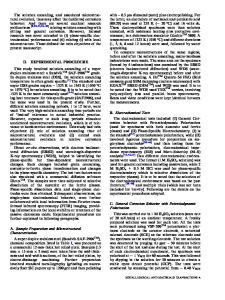Influence of Friction Stir Processing on Wear, Corrosion, and Fracture Toughness Behavior of 2507 Super Duplex Stainless
- PDF / 3,104,930 Bytes
- 14 Pages / 593.972 x 792 pts Page_size
- 87 Downloads / 329 Views
ÓASM International 1059-9495/$19.00
Influence of Friction Stir Processing on Wear, Corrosion, and Fracture Toughness Behavior of 2507 Super Duplex Stainless Steel Hafiz M. Abubaker, Nec¸ar Merah, Fadi Al-Badour, Ahmad A. Sorour, Anwar Ul-Hamid, A. Madhan Kumar, and Jafar Albinmousa Submitted: 2 June 2020 / Revised: 19 October 2020 / Accepted: 26 October 2020 Super duplex stainless steels (SDSS) are used in offshore applications and oil/gas plants operating under severe service conditions due to their superior mechanical and electrochemical properties. Fracture toughness, wear and corrosion resistance of a material depends largely on its microstructure and can be improved by refining the latter. Friction stir processing (FSP) can be employed to refine the microstructure of the material, resulting in superior fracture toughness, wear, and corrosion resistance. In the present research, SAF 2507 SDSS was subjected to FSP with optimized processing parameters to study the influence of FSP on fracture toughness, wear, and corrosion resistance of the material. It was observed that FSP refined alloy grains by decreasing the grain size from an average of 160 lm in the base metal to 2-30 lm in the stir zone. Refinement of grains increased the hardness of the material, which enhanced its wear resistance by more than 15%. Wear track and debris analysis revealed the change in wear mechanism of the processed material. FSP also modified the surface composition of processed material, which served to improve its corrosion resistance by more than 80%. Morphology of the corroded surfaces of base and processed material showed that the processed material was more resistant to corrosive attacks than base material. FSP enhanced the grain boundaries in the processed region which improved the fracture toughness after exposure to accelerated corrosion by about 26%. Fractographic study revealed that processed material had brittle fracture behavior while base material had ductile fracture behavior. Keywords
2507 SDSS, corrosion resistance, fracture toughness, friction stir processing, wear resistance
1. Introduction Super duplex stainless steel (SDSS) has large amounts of chromium, nickel, and molybdenum and its structure is constituted of iron-rich a-ferrite and c-austenite phases (Ref 1). Based on its composition, SDSS exhibits high fracture toughness, corrosion and wear resistance (Ref 1, 2). SDSS is mainly used in components exposed to severe environments, which tend to adversely affect its fracture toughness, corrosion, and wear properties. Various surface modification techniques can be utilized to enhance the afore-mentioned properties of SDSS.
Hafiz M. Abubaker, Nec¸ar Merah, Fadi Al-Badour, and Jafar Albinmousa, Department of Mechanical Engineering, King Fahd University of Petroleum and Minerals, Dhahran 31261, Saudi Arabia; Ahmad A. Sorour, Department of Mechanical Engineering, King Fahd University of Petroleum and Minerals, Dhahran 31261, Saudi Arabia; and Center of Research Excellence in Corrosion, Research Institute, King Fahd Universi
Data Loading...











